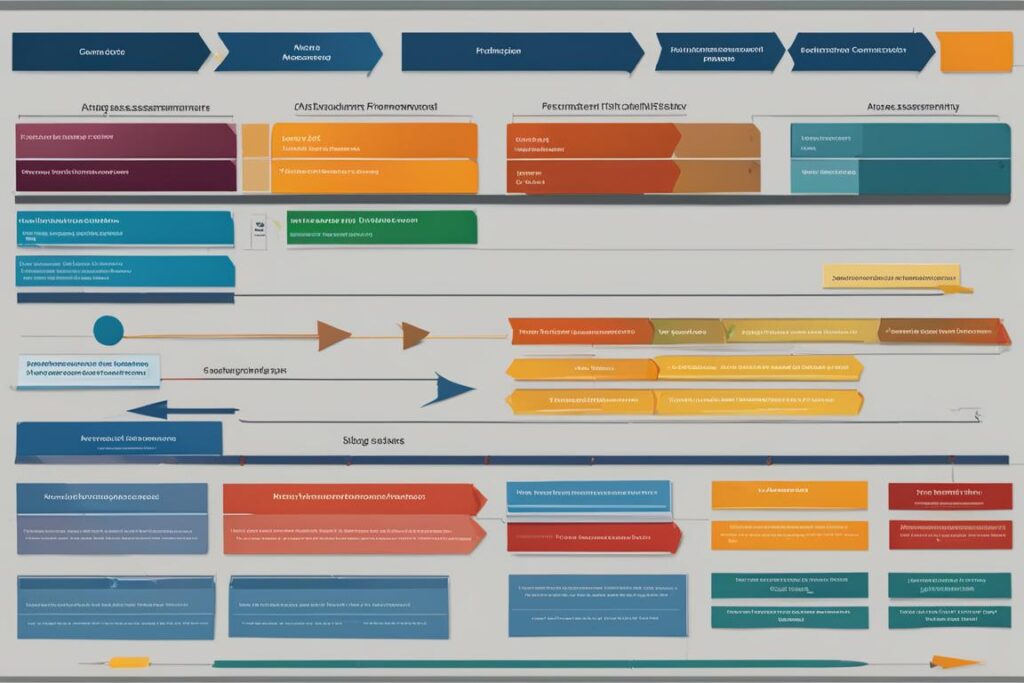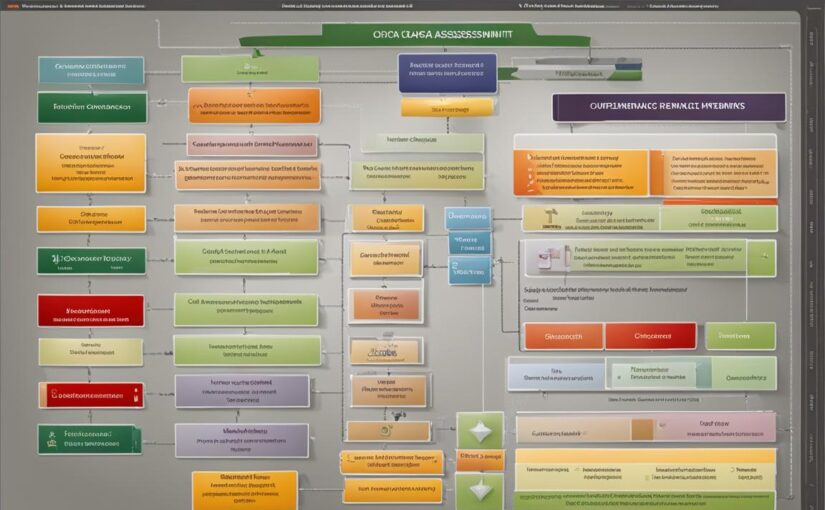Welcome to our comprehensive guide on risk assessment frameworks. In this article, we will explore the importance of having a robust risk assessment framework in place, and how it can help organizations effectively manage and mitigate potential risks. From risk analysis to risk mitigation, we will cover the essential components and processes involved in a risk assessment framework.
Before we dive into the details, let’s clarify what a risk assessment framework is. Essentially, it is a strategy that enables organizations to prioritize and share information about security risks to their IT infrastructure. By employing consistent assessment methods, a shared vocabulary, and a reporting system, organizations can identify systems at risk and take proactive measures to address potential threats.
The most common risk assessment frameworks include FAIR, COSO, COBIT, OCTAVE, NIST, and TARA. These frameworks provide organizations with structured approaches to identify, measure, prioritize, and mitigate risks. They emphasize the importance of consistent monitoring and regular reviews to ensure the effectiveness of the risk assessment process. Implementing a risk assessment framework is crucial for organizations aiming to strengthen their risk management practices and enhance overall cybersecurity.
Throughout this article, we will explore different types of risk assessment frameworks, including their industry standards and methodologies. We will also discuss how to create a risk assessment framework tailored to an organization’s specific needs. Additionally, we will highlight the importance of third-party risk assessments and delve into the NIST 800-30 risk assessment framework for federal agencies.
By the end of this article, you will have a comprehensive understanding of risk assessment frameworks and their significance in supporting informed decision-making, complying with regulations, and safeguarding sensitive information. Let’s get started on this journey to effective risk management together!
What is a Risk Assessment Framework?
A risk assessment framework is a strategic approach to prioritize and communicate information about security risks to an organization’s IT infrastructure. It plays a crucial role in identifying systems at risk and proactively addressing potential threats. By organizing and presenting information in a way that both technical and non-technical personnel can understand, a risk assessment framework enables effective risk management.
A key aspect of a risk assessment framework is the establishment of a shared vocabulary, ensuring that all stakeholders can communicate effectively and understand the risks involved. This shared understanding facilitates consistent assessment methods, enabling accurate evaluation and comparison of risks across different systems and areas within the organization.
Consistency in assessment methods allows for more efficient decision-making and prioritization of resources in addressing security risks. It ensures that risks are evaluated using standardized criteria, reducing ambiguity and enabling meaningful comparisons.
In addition, a risk assessment framework includes a reporting system that helps in documenting and tracking risk assessments. This system captures crucial information about identified risks, their potential impact, and recommended mitigation strategies. The reporting system serves as a valuable tool for monitoring the progress of risk mitigation initiatives and communicating the current risk landscape to relevant stakeholders.
Common risk assessment frameworks used by organizations include FAIR, COSO, COBIT, OCTAVE, NIST, and TARA. Each framework provides a structured approach to risk assessment, emphasizing the identification, evaluation, and management of security risks.

A risk assessment framework helps organizations align their risk management efforts with industry best practices and compliance requirements. It empowers them to make informed decisions, allocate resources effectively, and protect their IT infrastructure from potential security breaches.
Types of Risk Assessment Frameworks
When it comes to risk assessment frameworks, there are several industry standards that organizations can rely on. These frameworks use different approaches to assess risk and provide a structured process for organizations to identify, evaluate, and mitigate potential risks. Let’s take a closer look at some of the most widely accepted risk assessment frameworks:
1. FAIR (Factor Analysis of Information Risk)
FAIR is a quantitative risk assessment framework that focuses on measuring and evaluating the impact of potential risks. It takes into account factors such as loss magnitude, threat frequency, vulnerability, and controls strength. By utilizing a mathematical approach, FAIR enables organizations to make informed decisions based on a thorough understanding of risks.
2. COSO (Committee of Sponsoring Organizations of the Treadway Commission)
COSO is a widely recognized risk assessment framework that emphasizes the importance of internal controls and corporate governance. It provides a holistic approach to risk management, integrating risk assessment with strategic planning and internal control systems. COSO helps organizations identify, analyze, and respond to risks within a comprehensive framework.
3. COBIT (Control Objectives for Information and Related Technologies)
COBIT is a risk assessment framework specifically tailored for IT governance and management. It provides a set of best practices and control objectives to help organizations address risks related to IT processes, data management, and information security. COBIT helps organizations align their IT goals with business objectives, ensuring effective risk management.
4. OCTAVE (Operationally Critical Threat, Asset, and Vulnerability Evaluation)
OCTAVE is a risk assessment framework developed by Carnegie Mellon University’s Software Engineering Institute. It focuses on helping organizations assess and manage operational risks related to information security. OCTAVE emphasizes the importance of proactive risk assessments, asset identification, and vulnerability management.
5. NIST (National Institute of Standards and Technology) Risk Management Framework
The NIST Risk Management Framework provides federal agencies with a structured approach to risk assessment and management. It emphasizes the importance of categorizing, assessing, and prioritizing risks based on organizational objectives and information systems. The NIST framework helps federal agencies create effective risk management strategies to protect sensitive information.
6. TARA (Threat and Risk Assessment)
TARA is a risk assessment framework commonly used in the information security field. It focuses on identifying and evaluating risks associated with threats, vulnerabilities, and potential impacts. TARA helps organizations understand the potential consequences of risks and develop appropriate risk mitigation strategies.
These risk assessment frameworks provide organizations with a systematic approach to identify, measure, and prioritize risks. By utilizing industry standards such as FAIR, COSO, COBIT, OCTAVE, NIST, and TARA, organizations can strengthen their risk management practices and make more informed decisions to protect their assets and achieve their objectives.

How to Create a Risk Assessment Framework
To create a risk assessment framework, organizations have several options. They can utilize or customize established guides provided by reputable sources such as NIST, OCTAVE, or COBIT. These frameworks offer comprehensive guidance and best practices for conducting effective risk assessments.
An alternative approach is to develop a risk assessment framework that aligns with the specific business requirements of the organization. This allows for customization and flexibility in addressing unique risks and challenges.
When creating or modifying a risk assessment framework, it is essential to incorporate a risk assessment framework template. Templates provide a structured and systematic approach to evaluating risks across different domains. They offer predefined categories, criteria, and methodologies that help ensure comprehensive coverage of potential risks.
One important aspect to consider in the risk assessment framework is the use of a uniform numerical scale. Using a consistent numerical scale, such as a scale of 1 to 10, enables organizations to assess risks consistently and objectively, facilitating meaningful comparisons between different risks.
Clear definitions for the numerical scale should be provided to reduce ambiguity and ensure a common understanding across the organization. This allows individuals involved in the risk assessment process to evaluate risks consistently, enhancing the reliability and effectiveness of the framework.
Sample Risk Assessment Framework Template
Below is an example of a risk assessment framework template:
| Risk Category |
Risk Description |
Likelihood |
Impact |
Risk Level |
| Network Security |
Unauthorized access to network infrastructure |
7 |
9 |
High |
| Data Privacy |
Loss or unauthorized disclosure of sensitive data |
6 |
8 |
High |
| Physical Security |
Break-in or theft of physical assets |
3 |
5 |
Medium |
This template provides a structured framework for assessing risks in different categories. It includes columns for risk descriptions, likelihood of occurrence, impact, and risk levels. By populating this template with relevant information, organizations can systematically evaluate risks and prioritize their mitigation strategies.
Remember, the risk assessment framework should be tailored to the organization’s specific needs and context. Regular reviews and updates are essential to ensure its continued relevance and effectiveness in addressing emerging risks.
The Importance of Third-Party Risk Assessments
When it comes to risk assessment frameworks, one often overlooked aspect is the evaluation of risks associated with third-party vendors. Many organizations face challenges when it comes to assessing and managing risks related to their vendors and external partners. However, the impact of breaches originating from vendors is on the rise, making third-party risk assessments an essential component of comprehensive risk management.
By conducting thorough third-party risk assessments, organizations can effectively identify and mitigate potential risks that may arise from their vendor relationships. These assessments provide insights into the security practices, data handling protocols, and overall risk posture of third-party vendors. With this information, organizations can make informed decisions and take proactive measures to protect sensitive information and maintain compliance with industry regulations.
In today’s interconnected business landscape, organizations heavily rely on third-party vendors for various products and services, including cloud computing, software development, and supply chain management. While these partnerships offer several benefits, they also introduce new vulnerabilities and potential risks. Third-party risk assessments play a crucial role in evaluating the security measures implemented by vendors, assessing potential areas of weakness, and developing risk mitigation strategies.
Implementing effective third-party risk assessment processes may involve additional costs and resources. However, the potential consequences of neglecting these assessments far outweigh the initial investment. Breaches originating from third-party vendors can lead to financial losses, reputational damage, and regulatory non-compliance, resulting in hefty fines and penalties.
It’s essential for organizations to prioritize third-party risk assessments as part of their overall risk management strategy. By doing so, they can strengthen their cybersecurity posture, ensure the protection of sensitive information, and maintain compliance with industry regulations.
Remember, risk assessment is an ongoing process that requires regular reviews and updates to adapt to evolving threats and business needs. By implementing robust third-party risk assessments, organizations can stay ahead of potential risks and mitigate them effectively, safeguarding their operations and maintaining the trust of their stakeholders.
Quote: “In today’s interconnected business landscape, organizations heavily rely on third-party vendors for various products and services, including cloud computing, software development, and supply chain management. While these partnerships offer several benefits, they also introduce new vulnerabilities and potential risks.”
NIST 800-30 Risk Assessment Framework
The NIST 800-30 Risk Assessment Framework is a comprehensive framework developed specifically for federal agencies. It provides detailed guidance for conducting risk assessments of federal information systems and organizations. By using the NIST 800-30 framework, federal agencies can effectively identify and address potential risks to their cybersecurity programs and sensitive information.
The NIST 800-30 framework plays a crucial role in translating complex cyber threats into a language that all stakeholders can understand. It helps federal agencies develop a common understanding of the risks they face and enables informed decision-making in mitigating those risks.
To comply with NIST guidelines, including the NIST 800-30 framework, federal agencies must follow the recommended processes and procedures for conducting risk assessments. This is vital for strengthening their cybersecurity programs, protecting sensitive information, and ensuring compliance with federal regulations.
Implementing the NIST 800-30 framework involves the following key steps:
- Identifying the scope of the risk assessment
- Gathering relevant system information
- Conducting threat identification and vulnerability assessments
- Performing risk calculations and determining the potential impact
- Assessing the level of risk and prioritizing mitigation efforts
- Developing an action plan to address identified risks
- Implementing risk mitigation measures and monitoring their effectiveness
- Reviewing and updating the risk assessment periodically
By following these steps, federal agencies can systematically assess and manage risks, making informed decisions to protect their information systems and sensitive data.
“The NIST 800-30 Risk Assessment Framework empowers federal agencies to proactively address cybersecurity risks and protect sensitive information through a structured and standardized approach. By providing detailed guidance and a common language for risk assessments, NIST 800-30 helps agencies make informed decisions in mitigating potential threats.”
Key Components of the NIST 800-30 Risk Assessment Framework
| Component |
Description |
| Scope |
Defines the boundaries and objectives of the risk assessment |
| Threat Identification |
Identifies potential threats and their likelihood of occurrence |
| Vulnerability Assessment |
Evaluates system vulnerabilities that can be exploited by threats |
| Risk Calculation |
Quantifies the level of risk based on threats and vulnerabilities |
| Impact Assessment |
Evaluates the potential consequences of identified risks |
| Risk Prioritization |
Ranking risks based on their potential impact and likelihood |
| Mitigation Plan |
Defines actions to reduce or eliminate identified risks |
| Mitigation Monitoring |
Tracking the effectiveness of risk mitigation measures |
Conclusion
A risk assessment framework is a vital tool for organizations to effectively manage potential risks, protect sensitive information, and ensure compliance. By implementing a robust risk assessment framework, businesses can strategically prioritize and address risks, enhancing their overall cybersecurity posture and enabling informed decision-making.
Continuous assessment and management of risks should be an ongoing process, with regular reviews, updates, and adjustments in response to ever-evolving threats and changing business needs. These frameworks provide a structured approach to risk management, facilitating the identification, evaluation, and mitigation of potential risks.
Ultimately, a well-designed risk assessment framework empowers organizations to proactively identify vulnerabilities, minimize the likelihood of security incidents, and safeguard their sensitive data. By adhering to industry standards and employing best practices, organizations can effectively manage risks, ensuring the protection of their assets and maintaining compliance with relevant regulations.





